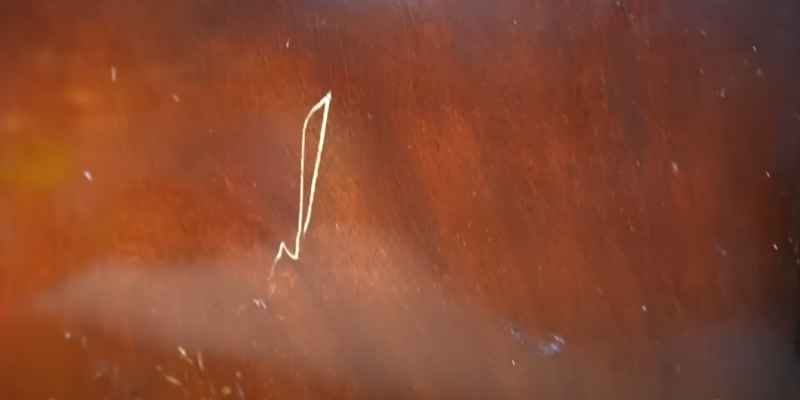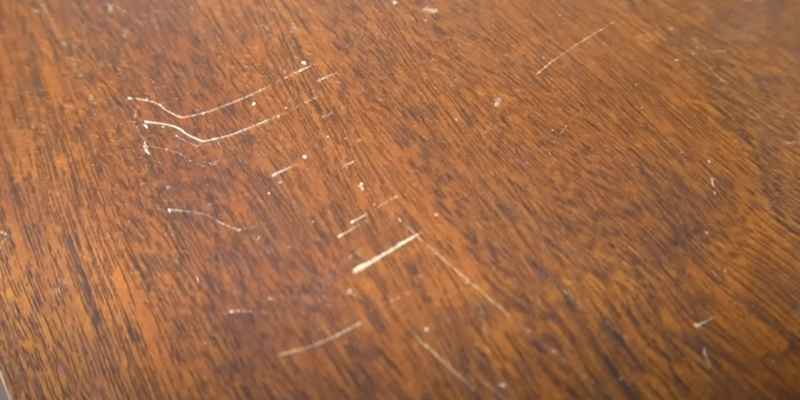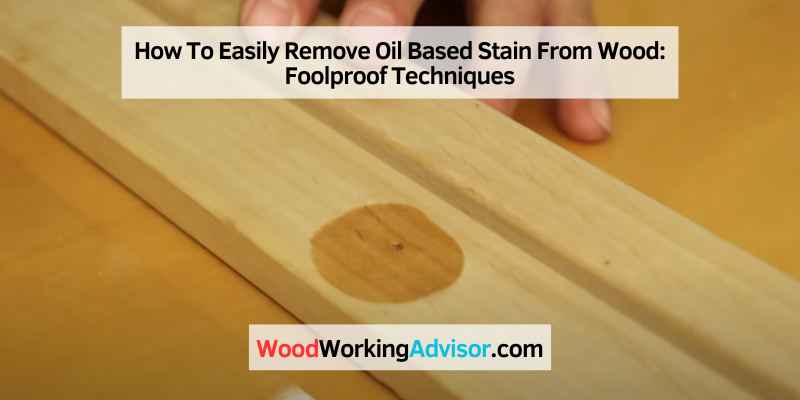To remove an oil-based stain from wood, apply a mixture of dish soap and warm water onto the stained area, scrub gently using a soft cloth or sponge, then rinse thoroughly. Wood furniture and flooring add a touch of elegance and beauty to any space.
However, accidents happen, and sometimes oil-based stains can appear on these surfaces. Whether it’s from a cooking mishap or a spill, removing oil-based stains from wood can seem like a daunting task. But fear not, as there is a simple solution.
In this guide, we will walk you through the process of removing oil-based stains from wood, using easily available household items and a few simple steps. So, let’s dive in and get your wood looking good as new again!
Understanding Oil Based Stains
When it comes to maintaining the beauty of wooden surfaces, it’s crucial to understand the different types of stains that may occur. One of the most common types is an oil based stain, which can be a real headache to remove if not tackled properly. In this article, we will dive into what oil based stains are, some common examples, and effective methods to remove them from wood.
What Are Oil Based Stains?
Oil based stains, as the name suggests, are stains that contain oils or petroleum-based liquids. These stains occur when oil-based substances are accidentally spilled or dripped onto wood surfaces. Unlike water-based stains, oil based stains don’t easily penetrate the wood and tend to form a more substantial barrier on the surface.
Common Examples Of Oil Based Stains
- Grease stains: These stains are often caused by cooking oil or foods containing oil. They can easily occur in kitchens or dining areas where oil splatters are common.
- Motor oil stains: Whether it’s from a leaking vehicle or spilled during maintenance work, motor oil stains can leave unsightly marks on wooden garage floors or driveways.
- Furniture polish stains: While furniture polish is meant to enhance the beauty of wood, if applied excessively or unevenly, it can result in a residue that leaves behind sticky stains over time.
- Insect repellent stains: Repellents that contain oil-based ingredients can lead to stains if accidentally sprayed onto wooden surfaces.
To effectively remove oil based stains, it’s essential to follow the right cleaning methods and use appropriate cleaning agents. In the upcoming sections of this blog post, we will discuss various methods to remove oil based stains from wood. So, stay tuned!

Preparation For Stain Removal
If you’re dealing with an oil-based stain on your wooden furniture or flooring, it’s crucial to prepare for the stain removal process properly. Taking the time to gather necessary materials and test an inconspicuous area beforehand can save you from damaging the wood further. In this section, we’ll guide you through the necessary preparations to ensure a successful stain removal. Let’s dive in!
Gathering Necessary Materials
Before you start removing the oil-based stain from the wood, make sure you have all the necessary materials at hand:
- Protective gloves to keep your hands safe during the stain removal process.
- Lint-free cloths or paper towels to blot and clean the stained area.
- Mineral spirits or a commercial stain remover specifically designed for oil-based stains.
- Preparation solution, such as a wood cleaner or mild detergent, for preliminary cleaning.
- Soft-bristled brush or toothbrush to gently scrub the stained area.
- Warm water for diluting the cleaning solutions and rinsing the wood.
Testing An Inconspicuous Area
Before you proceed with stain removal on the affected area, it’s essential to test the solution or cleaner on an inconspicuous corner or spot of the wood. This test will help you ensure that the cleaner or solvent does not harm or discolor the wood surface.
To perform the inconspicuous area test, follow these simple steps:
- Dilute the cleaning solution or mineral spirits according to the instructions provided.
- Apply a small amount of the solution onto a clean cloth or paper towel.
- Gently rub the solution on a hidden corner or underneath the furniture to check for any adverse reactions.
- Observe the area for several minutes to see if there is any color change or damage to the wood finish.
- If the test area appears unaffected, you can proceed with confidence to remove the oil-based stain from the visible stained area.
Techniques For Removing Oil Based Stains
When it comes to removing oil-based stains from wood, there are a few tried and tested techniques you can use to get the job done effectively. From blotting the stain to using household ingredients like dish detergent, vinegar, or baking soda, you’ll have plenty of options to choose from. Let’s explore each technique in detail to find the one that suits your needs best.
Blotting The Stain
To start the process of removing an oil-based stain from wood, you’ll want to begin by blotting the stain as soon as possible. Take a clean, absorbent cloth or paper towel, and gently blot the stain to soak up as much of the oil as you can. Avoid rubbing the stain as it may only spread the oil further. Remember to work inwards from the outer edges of the stain to prevent it from spreading.
Using Dish Detergent
- Start by creating a solution of warm water and a few drops of mild dish detergent.
- Dampen a clean cloth or sponge with the solution and gently scrub the stained area, working in circular motions.
- Rinse the cloth or sponge with clean water and continue to wipe the area, removing any soapy residue.
- Finally, dry the wood thoroughly with a clean towel or allow it to air-dry completely.
Applying Vinegar And Water Solution
- Mix equal parts white vinegar and water in a spray bottle or a bowl.
- Spray or apply the solution to the stained area and let it sit for a few minutes.
- Gently scrub the area with a soft brush or cloth, paying attention to the direction of the wood grain.
- Wipe away the solution with a clean, damp cloth.
- Dry the wood with a towel or let it air-dry.
Using Baking Soda Paste
- Create a paste by mixing baking soda with enough water to form a thick, spreadable consistency.
- Apply the paste directly to the oil-based stain, making sure to cover it completely.
- Leave the paste on the stain for a few minutes to allow it to absorb the oil.
- Gently scrub the stained area with a soft brush or cloth.
- Remove the paste with a clean, damp cloth and dry the wood thoroughly.
Remember, it’s essential to test these techniques in an inconspicuous area first to ensure they do not damage or discolor the wood. If the oil-based stain persists or the wood surface requires professional attention, consider consulting a wood care specialist.
Additional Tips And Tricks
In addition to the main methods outlined above, there are a few additional tips and tricks that can help you effectively remove oil-based stains from wood. By incorporating these techniques into your stain removal process, you can ensure optimal results and restore the natural beauty of your wooden surfaces.
Using Mineral Spirits
To tackle stubborn oil-based stains, one effective method is to use mineral spirits. This powerful solvent helps to dissolve and remove the stain from the wood. Here’s how to use mineral spirits to remove oil-based stains:
- Put on protective gloves and work in a well-ventilated area.
- Moisten a clean cloth or sponge with mineral spirits.
- Gently rub the stained area in a circular motion, applying slight pressure.
- Continue rubbing until the stain starts to lift.
- Wipe away any residue with a clean cloth.
Applying Wood Bleach
If the oil-based stain has penetrated the wood deeply and is difficult to remove, using wood bleach can be an effective solution. Wood bleach lightens the stained area, minimizing its visibility. Follow these steps to apply wood bleach:
- Prepare the area by removing any existing finish or sealant.
- Put on protective gloves and work in a well-ventilated area.
- Mix the wood bleach according to the manufacturer’s instructions.
- Apply the wood bleach to the stained area using a clean brush or sponge.
- Allow the bleach to sit for the recommended amount of time.
- Rinse the area thoroughly with clean water.
- Allow the wood to dry completely before proceeding with refinishing.
Sanding The Stained Area
If the stain persists after attempting the above methods, you may need to resort to sanding the stained area. Sanding helps to remove the top layer of wood, including the stained portion. Follow these steps to sand the stained area:
- Ensure the wood is completely dry before sanding.
- Start with a coarse-grit sandpaper and gradually move to a finer grit.
- Sand in the direction of the wood grain to avoid damaging the surface.
- Continue sanding until the stain is no longer visible.
- Wipe away the sanding dust with a clean cloth.
- Apply a suitable finish or sealer to protect the newly cleaned wood.
By incorporating these additional tips and tricks into your stain removal process, you can effectively banish oil-based stains from your wooden surfaces. Remember to always work carefully and take necessary safety precautions when using solvents and bleach. With patience and persistence, you can restore the natural beauty of your wood and enjoy its timeless appeal for years to come.

Preventing Future Oil Based Stains
To prevent future oil-based stains on wood, it is essential to act promptly. Clean the affected area using a mixture of warm water and mild dish soap, and gently scrub the stain away. Afterwards, apply a wood sealant to protect the surface from potential stains.
If you want to keep your wooden furniture or flooring looking pristine and oil-stain-free, there are a few preventive measures you can take. By using protective coatings and cleaning spills immediately, you can ensure that your wood remains beautiful for years to come.
Using Protective Coatings
To safeguard your wood against oil-based stains, applying a protective coating is crucial. These coatings act as a barrier, preventing oil from penetrating the wood’s surface. Here are a few types of protective coatings you can consider:
- Varnish: A popular choice for sealing wood, varnish provides a durable layer of protection. It’s available in different finishes, including matte, satin, and glossy.
- Polyurethane: Known for its resistance to oil and water, polyurethane is an excellent option for protecting wood against oil-based stains.
- Shellac: Derived from natural sources, shellac forms a hard and protective coating. It is easy to apply and offers good resistance to oils.
With any protective coating, it’s important to follow the manufacturer’s instructions for application. Ensure that the wood is clean and dry before applying the coating. Apply multiple thin coats, allowing each coat to dry completely before adding the next one.
Cleaning Spills Immediately
Accidents happen, and if an oil spill occurs on your wooden surface, swift action is essential to prevent staining. Cleaning spills immediately can help minimize the chances of the oil penetrating the wood, saving you from a potential headache. Here’s what you can do:
- Act quickly: As soon as you notice a spill, grab a clean cloth or paper towel and blot the oil gently. Avoid rubbing, as it can push the oil deeper into the wood.
- Use absorbent materials: If the oil stain persists, sprinkle baking soda or cornstarch on top of the affected area. These absorbent substances can help pull out the remaining oil.
- Clean with mild soap: Mix a few drops of mild dish soap with warm water and dampen a cloth. Gently wipe the stain, being careful not to oversaturate the wood.
- Dry thoroughly: After cleaning, ensure the wood is completely dry to prevent moisture-related issues. Use a clean cloth or allow the wood to air-dry naturally.
By following these simple steps, you can effectively prevent future oil-based stains on your wood surfaces. Remember to regularly inspect and maintain your protective coating to ensure its continued effectiveness. With a little bit of care and preventive action, your wooden furniture or flooring will remain beautiful and oil-stain-free.
Conclusion
To conclude, removing oil-based stains from wood can seem like a daunting task, but with the right techniques, it can be accomplished effectively. By using household items such as baking soda, vinegar, or dish soap along with gentle scrubbing and blotting, you can restore the beauty of your wooden surfaces.
Remember to always test the solution on a small, inconspicuous area first before applying it to the entire stain. With patience and care, your wood can be stain-free and rejuvenated once again.


